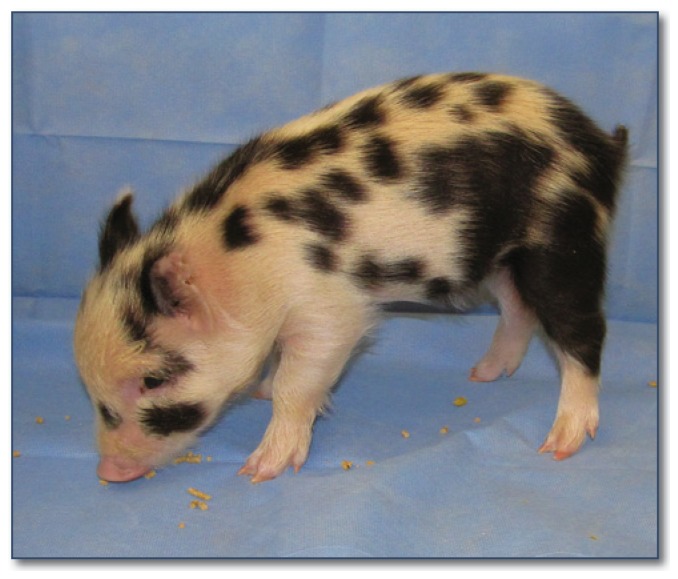Abstract
Swine models are relatively new kids on the block for modeling human health and diseases when compared to rodents and dogs. Because of the similarity to humans in size, physiology, and genetics, the pig has made significant strides in advancing the understanding of the human condition, and is thus an excellent choice for an animal model. Recent technological advances to genetic engineering of the swine genome enhance the utility of swine as models of human genetic diseases.
Introduction
Pigs are an ideal animal model for human health and diseases because their anatomy and physiology are similar to humans and because the porcine genome is three times closer than the mouse genome to that of the human.1 Moreover, the recently completed swine genome sequence (Sus scrofa Build 10) will help advance the pig as an animal model2 by facilitating the manipulation of genes. The pig has previously gained acceptance from the medical community for studies in organ transplantation, surgical training of medical students, and the development of novel techniques and medical devices. More recently, naturally occurring and genetically modified pig models have gained acceptance from the biomedical community as animal models for human health and diseases. This shift from the classical rodent model to the pig model for certain diseases has been largely due to the failure of several rodent models to recapitulate the physiology of the disease. One prominent example is cystic fibrosis. When the mutation that causes cystic fibrosis in humans is introduced into mice, the mouse does not recapitulate any of the human disease symptoms; however the recently developed pig model appears to fully mimic the human condition.3–6
Domestic swine have been selectively bred for centuries to produce animals with desired characteristics. Altering these characteristics to be more useful to researchers can be done quickly with genetic engineering, or altering the DNA sequence. The integration of foreign DNA into the genome provides a method to rapidly produce animals with a desired characteristic. In 1985, Hammer produced the first transgenic pig through microinjection of the foreign DNA into the pronuclei of the pig zygote.7 In addition to this method there are several other methods that can be used to produce transgenic pigs including the current standard method of somatic cell nuclear transfer (SCNT).8 SCNT can be used in combination with simple transgenesis, as well as advanced genetic manipulations to create knock-ins and knock-outs. More recently, there have been advances in genetic manipulation of cells that will allow more cell-based transgenesis such as Zinc Finger Nucleases and Transcription Activator-Like Effector Nucleases (TALENs) that will enhance the production of swine models for human health and diseases.
The Pig: An Animal Model
The classical rodent models have proved to be very important for understanding the basic biology of genes and proteins involved in human health and disease, but with limited ability to recapitulate some human diseases, their usefulness is restricted. In addition to cystic fibrosis, murine models of diseases such as Spinal Muscular Atrophy (SMA)9 and Parkinson’s disease10 are inadequate and swine models may prove to be superior.
The pig has many advantages as a non-rodent biomedical model because of the wealth of information about husbandry, logistical support, and reproductive management. Pigs reach sexual maturity at about six to eight months of age (domestic) and have a relatively short gestation period (~four months) resulting in multiple births. Pigs are also not seasonal breeders so mating can occur year round. There are several genetic backgrounds of both domestic and miniature pigs that thrive in a variety of environmental conditions. The anatomical structure and function of the cardiovascular system, the gastrointestinal tract, and the pancreas of the pig are very similar to humans making them ideal models for investigating diseases related to these systems. Pigs have some notable difference when compared to humans. The pig lymph node is inverted compared to the human lymph node with follicles central to a peripheral medulla.11 Besides anatomy, genetic analysis has identified naturally occurring swine models for a variety of human health conditions such as hypercholesterolemia, puerperal psychosis, human melanocytic proliferation, and polycystic ovarian syndrome.12–16 In addition to the spontaneous pig models, genetically engineering the pig genome has allowed us to advance the understanding of genes, proteins, pharmacological “pharming,” and to develop organs for xenotransplantation.
Another potential use of the pig as an animal model is in the field of toxicology and drug discovery. With the physiologic similarities between pigs and human, the pig is becoming the non-rodent species of choice for toxicological studies. Examples are assessment of the effects of putative endocrine-disrupting compounds and drug discovery. Advantages of the pig to toxicology studies include: 1) they have a similar response to several varieties of drugs; 2) tissue and body fluid samples can be collected during the dosing period prior to euthanasia; 3) oral and parenteral dosing is similar to humans; and 4) the use of pigs eases some of the increasing societal pressure about using primates and dogs as animal models. The challenges to using swine as a model for toxicological studies include requirements for more experimental reagent, higher costs of purchase, and the requirement for more space which increases per diem costs and is not possible in some animal facilities. Some of these concerns can be addressed with the use of miniature pigs, and development and utilization of novel techniques such as xenografting procedures, proteomics, and metabalomics.
Currently there are 29 different lines of pigs (wild-type and genetically engineered) available for request from the NSRRC.
Genome and Transgenesis
The swine genome is estimated to be ~2.7 GB (about 7% smaller than the human genome), and is comprised of 18 autosomes and two sex chromosomes. The lineage of the pig and human genome (in comparison to the human and mouse) has a lower rate of nucleotide substitution with the exonic sequences showing the slowest evolution followed by the 5′ untranslated regions and 3′ untranslated regions, respectively.1 Having the sequenced pig genome will be advantageous in developing biomedical models where differences exist between the pig and human. An example of this is Spinal Muscular Atrophy (SMA). Humans have two survival motor neuron genes (SMN1 and SMN2), while the pig only has a single gene for SMN. With this knowledge of the pig and human genomes, investigators made appropriate adaptations to best recapitulate SMA in the pig. 9 This was achieved by adding a transgene for human SMN2 and subsequently disrupting swine SMN to simulate a disrupted SMN1 in humans with SMA.
Currently, there are many ways to produce genetically modified animals, however in the pig the most effective method is SCNT. 8 The first transgenic pig to model a human health condition17 was produced in 1996. Since that time, several transgenics, knock-ins and knock-outs have been produced (for further details see these reviews8,18). Somatic cell nuclear transfer provides us with an advantage over previous methodologies in that it allows gene targeting versus random insertion. The exact genetic modification can be determined prior to creating the animal. Gene targeting is a valuable tool for in vivo studies of gene expression, signaling pathways, and developmental biology and more advanced cell based transgenic techniques such as a Cre/Lox-P system and Zinc Finger Nucleases to avoid embryonically lethal targeting events are now amenable to swine genetic engineering.8 When designing the mutation to be made, the completed pig genome will allow us to have prior knowledge about alternative splice variants, isoforms, or locations in the genome where genetic modification can occur that have no effect on the animal (so called “safe harbors”). Comparative genomic analysis will help identify conserved cross-species genes and regulatory elements that can be utilized in the development of genetically modified pigs.
Swine Resources
There are many resources available for the pig as a biomedical model. With the release of the completed swine genome (Sus scrofa Build 10), there are several genomic resources available for the pig (ftp://ftp.ncbi.nih.gov/genbank/genomes/Eukaryotes/vertebrates_mammals/Sus_scrofa/Sscrofa10.2/ or www.ncbi.nlm.nih.gov/genome/guide/pig/). In 2003, the National Institutes of Health established the National Swine Resource and Research Center (NSRRC) (www.nsrrc.missouri.edu) at the University of Missouri. The goal of the NSRRC is provide the infrastructure to ensure that investigators have access to swine for their biomedical research through production of new genetically engineered pigs and reagents from animals already available. The NSRRC serves as a central resource for reagents, information, and training related to use of swine models in biomedical research. Investigators can donate swine models to the NSRRC for maintenance, production and distribution to the entire scientific community. Currently there are 29 different lines of pigs (wild-type and genetically engineered) available for request from the NSRRC as listed in Table 1 and the website. Furthermore, the NSRRC produces three to four new models for investigators each year.
Table 1.
NSRRC Swine Availability
| Strain Name | Modification(s) | Gene(s) | Application(s) |
|---|---|---|---|
| Truline® Hampshire | none | wildtype | background for genetic modification |
| Truline® Duroc | none | wildtype | background for genetic modification |
| Truline® Landrace | none | wildtype | background for genetic modification |
| Truline® Large White | none | wildtype | background for genetic modification |
| Minnesota Mini | none | wildtype | immune system ontogeny and regulation, xenotransplantation, xenoimmunotherapy of cancer |
| Ossabaw | none | wildtype | background for genetic modification, obesity, diabetes, cardiovascular, Polycystic ovarian syndrome |
| GGTA1KO/hDAF | transgenic targeted knock-out | α-1,3-galactosyltransferase knockout; human decay-accelerating factor | xenotransplantation research |
| GFP NT5 | transgenic | enhanced green fluorescent protein | cell tracking |
| FAT-1 | transgenic | express a humanized Caenorhabditis elegans gene, fat-1, encoding an n-3 fatty acid desaturase | research in the areas of reproduction, cardiovascular, immune system, depression and cancer |
| Yucatan | none | Wildtype | small porcine model as background for genetic modification |
| NIH Mini g/g | none | MHC SLA g/g | research in the areas of immune system, and xenotransplantation |
| NIH Mini c/c | none | MHC SLA c/c | research in the areas of immune system, and xenotransplantation |
| NIH Mini a/a | none | MHC SLA a/a | research in the areas of immune system, and xenotransplantation |
| GFP NT92 | transgenic | enhanced green fluorescent protein | cell tracking |
| Rhodopsin | transgenic | rhodopsin P23H substitution | retinitis pigmentosa research |
| FVIII | tri-transgenic | human coagulation factor VIII; human alpha-antitrypsin; propeptide cleavage enzyme (PACE) | hemophilia research |
| FIX | tri-transgenic | human coagulation factor IX; human alpha-antitrypsin; von Willebrand factor | hemophilia research |
| GFP NT92-Yucatan | transgenic | enhanced green fluorescent protein | cell tracking |
| Tie2-eNOS | transgenic | endothelial nitrate oxide synthase | cardiovascular, exercise physiology |
| Tie2-Catalase | transgenic | human catalase | cardiovascular, exercise physiology |
| PSMA1-GFP | transgenic | GFP-Proteasome Fusion Protein | proteasome research |
| Multi-Xeno | transgenic | α-1,3-galactosyltransferase knockout; human decay-accelerating factor (CD55); CD39; CD59 and thrombomodulin | xenotransplantation |
| NLS-CAG-eGFP | transgenic | nuclear localized signal-CAG-enhanced green fluorescent protein | cell tracking |
| CAG-Tomato | transgenic | CAG-Tomato | cell tracking |
| AFP-CD | transgenic | alpha fetoprotein promoter driving cytosine deaminase | liver research |
| ALB-TK | transgenic | albumin promoter driving thymidine kinase | liver research |
Summary
Although the pig is the relative ‘new kid’ on the block, pig models of human disease will continue to have a significant impact on the scientific community. With a sequenced porcine genome19 and advancements in genetic manipulations, the pig has become an optimal model for many human diseases. However, their greatest impact is likely yet to come with increasing recognition and use of these models by the biomedical research community.
Biography
Eric M. Walters, PhD, (left) and Randall S. Prather, PhD, are in the Division of Animal Sciences and National Swine Resource and Research Center, University of Missouri.
Contact: walterse@missouri.edu


Footnotes
Disclosure
None reported.
References
- 1.Wernersson R, Schierup MH, Jorgensen FG, Gorodkin J, Panitz F, Staerfeldt HH, et al. Pigs in sequence space: a 0.66X coverage pig genome survey based on shotgun sequencing. BMC Genomics. 2005;6:70. doi: 10.1186/1471-2164-6-70. [DOI] [PMC free article] [PubMed] [Google Scholar]
- 2.Groenen MA, Schook LB, Archibald AL. Pig Genomics. In: Rothschild MF, Ruvinsky A, editors. The genetics of the pig. Wallingford: CABI; Jan 1, 2011. pp. 179–199. [Google Scholar]
- 3.Rogers CS, Stoltz DA, Meyerholz DK, Ostedgaard LS, Rokhlina T, Taft PJ, et al. Disruption of the CFTR gene produces a model of cystic fibrosis in newborn pigs. Science. 2008;321:1837–1841. doi: 10.1126/science.1163600. [DOI] [PMC free article] [PubMed] [Google Scholar]
- 4.Stoltz DA, Meyerholz DK, Pezzulo AA, Ramachandran S, Rogan MP, Davis GJ, et al. Cystic fibrosis pigs develop lung disease and exhibit defective bacterial eradication at birth. Sci Transl Med. 2010;2:29ra31. doi: 10.1126/scitranslmed.3000928. [DOI] [PMC free article] [PubMed] [Google Scholar]
- 5.Welsh MJ, Rogers CS, Stoltz DA, Meyerholz DK, Prather RS. Development of a porcine model of cystic fibrosis. Trans Am Clin Climatol Assoc. 2009;120:149–162. [PMC free article] [PubMed] [Google Scholar]
- 6.Rogan MP, Reznikov LR, Pezzulo AA, Gansemer ND, Samuel M, Prather RS, et al. Pigs and humans with cystic fibrosis have reduced insulin-like growth factor 1 (IGF1) levels at birth. Proc Natl Acad Sci U S A. 2010;107:20571–20575. doi: 10.1073/pnas.1015281107. [DOI] [PMC free article] [PubMed] [Google Scholar]
- 7.Hammer RE, Pursel VG, Rexroad CE, Jr, Wall RJ, Bolt DJ, Ebert KM, et al. Production of transgenic rabbits, sheep and pigs by microinjection. Nature. 1985;315:680–683. doi: 10.1038/315680a0. [DOI] [PubMed] [Google Scholar]
- 8.Whyte JJ, Prather RS. Genetic modifications of pigs for medicine and agriculture. Mol Reprod Dev. 2011;78:879–891. doi: 10.1002/mrd.21333. [DOI] [PMC free article] [PubMed] [Google Scholar]
- 9.Lorson MA, Spate LD, Samuel MS, Murphy CN, Lorson CL, Prather RS, et al. Disruption of the Survival Motor Neuron (SMN) gene in pigs using ssDNA. Transgenic Res. 2011;20:1293–1304. doi: 10.1007/s11248-011-9496-8. [DOI] [PMC free article] [PubMed] [Google Scholar]
- 10.Swanson KS, Mazur Meredith J, Vashisht Kapil, Rund Laurie A, Beever Jonathan E, Counter Christopher M, et al. Genomics and Clinical Medicine: Rationale for Creating and Effectively Evaluating Animal Models. Experimental Biology and Medicine. 2004;229:866–875. doi: 10.1177/153537020422900902. [DOI] [PubMed] [Google Scholar]
- 11.Johnson David K, Wisner Erik R, Griffey Stephen M, Vessey Adele R, Haley Patrick J. Sinclair miniature swine melanoma as a model for evaluating novel lymphography contrast agents. In: Tumbleson Mike E, Schook L., editors. Advances in swine in biomedical research. New York City: Plenum Press; 1996. pp. 607–612. [Google Scholar]
- 12.Du ZQ, Vincent-Naulleau S, Gilbert H, Vignoles F, Crechet F, Shimogiri T, et al. Detection of novel quantitative trait loci for cutaneous melanoma by genomewide scan in the MeLiM swine model. Int J Cancer. 2007;120:303–320. doi: 10.1002/ijc.22289. [DOI] [PubMed] [Google Scholar]
- 13.Egidy G, Jule S, Bosse P, Bernex F, Geffrotin C, Vincent-Naulleau S, et al. Transcription analysis in the MeLiM swine model identifies RACK1 as a potential marker of malignancy for human melanocytic proliferation. Mol Cancer. 2008;7:34. doi: 10.1186/1476-4598-7-34. [DOI] [PMC free article] [PubMed] [Google Scholar]
- 14.Grunwald KA, Schueler K, Uelmen PJ, Lipton BA, Kaiser M, Buhman K, et al. Identification of a novel Arg-->Cys mutation in the LDL receptor that contributes to spontaneous hypercholesterolemia in pigs. J Lipid Res. 1999;40:475–485. [PubMed] [Google Scholar]
- 15.Quilter CR, Gilbert CL, Oliver GL, Jafer O, Furlong RA, Blott SC, et al. Gene expression profiling in porcine maternal infanticide: a model for puerperal psychosis. Am J Med Genet B Neuropsychiatr Genet. 2008;147B:1126–1137. doi: 10.1002/ajmg.b.30734. [DOI] [PubMed] [Google Scholar]
- 16.Lowe J, Krisher R, Sturek M. Characterizing the Ossabaw Mini-Pig as an Animal Model for Polycystic Ovary Syndrome. Biol Reprod. 2007;77(Suppl):210. [Google Scholar]
- 17.Petters RM, Alexander CA, Wells KD, Collins EB, Sommer JR, Blanton MR, et al. Genetically engineered large animal model for studying cone photoreceptor survival and degeneration in retinitis pigmentosa. Nat Biotechnol. 1997;15:965–970. doi: 10.1038/nbt1097-965. [DOI] [PubMed] [Google Scholar]
- 18.Walters EM, Wolf E, Whyte JJ, Mao J, Renner S, Nagashima H, et al. Completion of the swine genome will simplify the production of swine as a large animal biomedical model. BMC Medical Genomics. 2012;5:55. doi: 10.1186/1755-8794-5-55. [DOI] [PMC free article] [PubMed] [Google Scholar]
- 19.Groenen MA, Archibald AL, Uenishi H, Tuggle CK, Takeuchi Y, Rothschild MF, et al. Analyses of pig genomes provide insight into porcine demography and evolution. Nature. 2012;491:393–398. doi: 10.1038/nature11622. [DOI] [PMC free article] [PubMed] [Google Scholar]



